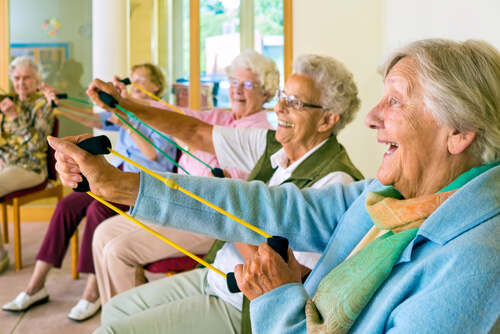
Should Physical Exercise Be Part of Home Care Services?
Doctors keep saying it, and nearly everyone acknowledges it: a sedentary lifestyle is a major health risk, especially for seniors. In light of this, today’s senior living facilities, particularly assisted living facilities, near-ubiquitously have exercise rooms to host exercise classes, to allow seniors to remain active, and to help seniors maintain strength and balance. But among home care services — a cheaper, more attractive alternative for many seniors — physical exercise programs remain conspicuously absent. If promoting good health is a goal of home care and home health services, why has seemingly no one approached the issue of staying active at home?
There are, of course, certain conditions that prevent home care providers from offering fitness services. Chiefly among these is the fact that caregivers are not qualified to work with patients on physical fitness. Also a problem is the major risk of liability that comes with any physical exercise program. One mistake from a caregiver, and they could potentially face crippling fines from a lawsuit. This risk is especially high among the population home care companies serve because the risk of injury from physical exercise rises as we age.
Yet the risks posed by inactivity, such as muscle wasting, weakness, risk of fall, increased risk of vascular disease, among many others, are an ever-looming threat to seniors. Staying at home is no help, either, because it encourages sedentary behavior. It is much easier (and safer) to sit and watch television than to go out and exercise. Therefore it is essential that physical exercise somehow be incorporated as part of home care services to help negate this trend. Such services would help seniors at home set aside blocks of time to exercise, and they would be held accountable by another person to keep it up.
The benefits of exercise far outweigh the risks. In a 2012 TED talk titled “Why bodybuilding at age 93 is a Great Idea”, speaker Charles Eugster spoke at length about the benefits of exercise among the aged, and how it is never too late to begin a fitness journey. “Successful aging requires work, diet and exercise,” Charles said. “The huge mental and physical potential of the aged remains unexplored. Bodies can now be rebuilt at any age and a new life started. Beauty kings and queens in the 80-year-old category or a beach body at the age of 94 are not impossible. We will all, regardless of age, have to take greater responsibility for our own health in order to confront the immense challenges confronting the human race.”
How Can Home Care Companies Incorporate Physical Exercise as a Service?
As previously stated, caregivers are not qualified to provide fitness services. This means home care providers will need to either hire, or partner with, qualified fitness industry experts. Personal trainers are certified by a variety of governing bodies, such as the International Sports Sciences Association, and typically carry their own insurance regardless of where they train. Many personal trainers already work with some clients at home, and they cover themselves of the liability associated therein through the proper paperwork. It is not a major leap to say that it would be incredibly easy to find a fitness trainer who would be wiling to work with seniors at home.
Fitness services would need to be offered separately as a recommended service, and the fitness trainers themselves would need be hired as private contractors rather than employees. They would charge their own fees for training, and owe to the home care provider a percentage of their fee for the referrals. The arrangement would not be dissimilar to the arrangements personal trainers already have with gyms, except they instead would be training clients from home.
The other option would be to hire a personal trainer directly. In this case, a home care provider would need to prepare paperwork to reflect that they are liable for issues that may arise and are responsible for covering the personal trainer’s insurance. There is also the regulatory hurdle to consider. Home care providers in many states are carefully licensed and regulated, which means employing a personal trainer to have on staff may pose unforeseen challenges. The only way to change this would be to lobby for change in regulations to include fitness training services within the current body of regulations. Hence why hiring a personal trainer as a private contractor is easier.
Should the home care industry include fitness as one of their services? The answer is yes, but how each individual provider does so, and whether or not they do, is entirely up to them. Invariably, those who adopt fitness as a service and figure out how to make it work, and work well, will gain a tremendous competitive advantage over their competitors. More importantly, they will be benefiting their patients in an entirely new and positive way, which is exactly what a provider should want to do.






